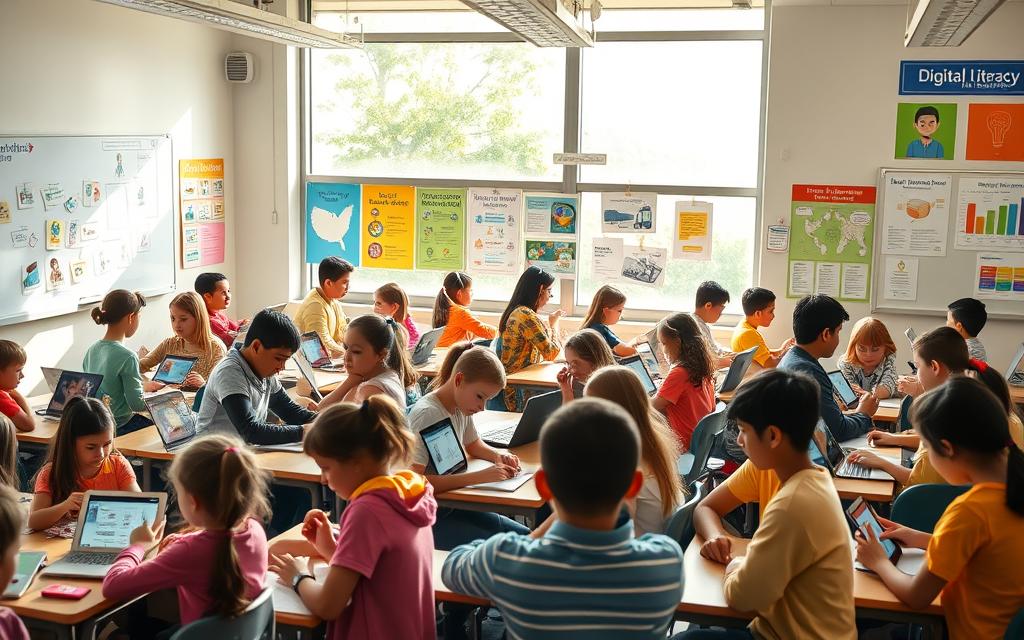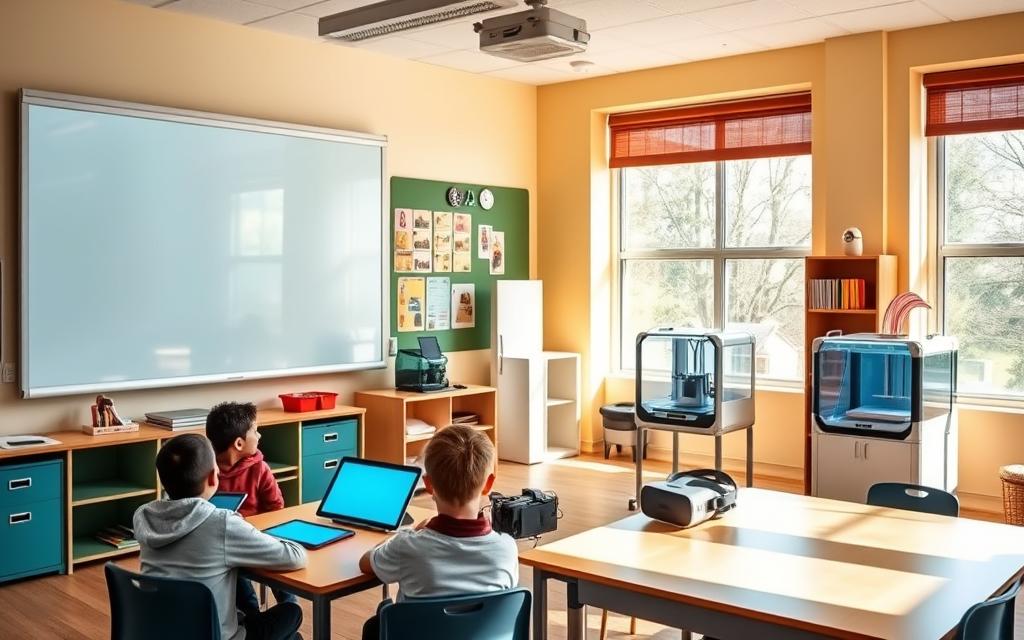Imagine a classroom where students are fully engaged. Their curiosity is sparked by digital tools that make learning fun. This dream is becoming real, thanks to educational technology (edtech). It’s changing how we teach and learn.
A recent survey shows that 98% of educators think tech is key for digital age prep.
Technology in the classroom is more than a trend. It’s a big change in how we learn. With new edtech tools, educators can open doors to creativity and critical thinking. These skills are vital for tomorrow’s leaders.
Key Takeaways
- Educational technology is rapidly transforming the learning landscape, with 98% of educators recognizing its importance.
- Integrating technology in the classroom empowers educators to create dynamic, engaging learning experiences.
- Edtech solutions can foster creativity, critical thinking, and the development of essential skills for the digital age.
- Embracing educational technology is a crucial step in preparing students for the future and equipping them with the tools they need to succeed.
- Empowering educators with technology is the key to unlocking the full potential of 21st-century learning.
Understanding the Digital Transformation in Education
The education world is changing fast, thanks to new tech and digital skills. This change is making learning, teaching, and schools better. It’s bringing in new ways to teach and learn.
Current State of Educational Technology
Digital tech is now a big part of schools. Classrooms have interactive tools like whiteboards and laptops. This makes learning more fun and interactive.
Online learning and apps have made education more accessible. Students can now learn at their own speed and in their own way.
Key Drivers of Digital Change
- Advancements in digital literacy and digital-savvy student population
- Increased demand for personalized and adaptive learning experiences
- Growing emphasis on 21st-century skills and collaborative learning
- Availability of affordable and user-friendly edtech tools and platforms
- Necessity for remote and hybrid learning models during the COVID-19 pandemic
Impact on Traditional Teaching Methods
Technology has changed how teachers teach. Now, they use tech to make learning more engaging. This mix of digital and face-to-face learning makes lessons more interactive.
Teachers can now tailor lessons to each student. This helps students learn better together and get feedback right away. It makes learning more effective and fun.

Essential Technology Tools for Modern Educators
In today’s fast-changing education world, tech-savvy teachers use many educational tools. These tools make teaching and learning better. They also help create fun and interactive classrooms for students.
Tools like interactive whiteboards and video conferencing platforms are key. They also include learning management systems and online tests. These tools help teachers offer more personalized and data-driven learning experiences.
Interactive Whiteboards and Displays
Interactive whiteboards and digital displays change how teachers teach. They let teachers add multimedia, write on lessons, and do group work. This makes learning more exciting and hands-on.
Learning Management Systems (LMS)
Systems like Canvas, Blackboard, or Google Classroom help manage courses. They make it easy to share assignments and track student progress. These systems help teachers focus on teaching and make learning more personal.
Video Conferencing and Collaboration Tools
- Tools like Zoom or Microsoft Teams let teachers teach from anywhere. This is great for remote or hybrid learning.
- Tools like Google Suite or Microsoft 365 help with teamwork. They make it easy to edit documents and share files together.
Online Assessment and Feedback Tools
- Tools like Kahoot or Quizziz give quick feedback. They help teachers see if students get the material and adjust their teaching.
- Tools like Canvas’ SpeedGrader or Google Classroom’s comments make giving feedback easier. They help students learn more actively.
As technology in education grows, tech-savvy teachers are leading the way. They use these tools to make learning more engaging, personal, and based on data. This helps students learn better.

Bridging the Digital Divide: Access and Equity in EdTech
In today’s digital world, making sure everyone has equal access to educational technology (edtech) is key. This helps teachers and creates fair learning spaces. But, not all schools can afford the tech they need, leading to a digital gap.
Addressing Technology Gaps
To close this gap, we need teamwork from policymakers, school leaders, and tech experts. They should invest in better tech and internet for all. This way, every student can use edtech to learn and grow.
Creating Inclusive Digital Learning Environments
It’s not just about having tech. We must make learning spaces welcoming for everyone. This means tech that works for all students, training for teachers, and support for everyone.
Solutions for Resource-Limited Schools
- Collaborative funding initiatives between public and private sectors to support technology investments in resource-limited schools
- Partnerships with community organizations and local businesses to leverage resources and expertise
- Innovative implementation of cost-effective, open-source educational technology solutions
- Comprehensive professional development programs for educators to maximize the impact of available technology
By tackling the digital divide, we can help teachers use tech to its fullest. This way, every student gets a fair chance to learn, no matter their background or where they live.
Building Digital Literacy Among Teaching Staff
The digital world is changing education fast. Teachers need to keep up with new tech. They must learn to use technology well to teach students in new ways.
Teachers need training and support to become tech-savvy. Schools should help them grow professionally. This way, teachers can teach in a modern, engaging way.
Strategies for Enhancing Digital Literacy
- Comprehensive training programs that cover a wide range of digital tools and applications
- Hands-on workshops that allow teachers to experiment with and master new technologies
- Peer-to-peer learning sessions where experienced teachers can share best practices and lessons learned
- Mentorship programs that pair tech-savvy educators with those seeking to enhance their digital skills
- Ongoing professional development opportunities, such as webinars, online courses, and industry conferences
When schools focus on digital literacy, teachers become tech experts. This changes how they teach, making learning more fun and interactive for students.
By focusing on digital literacy, schools improve teaching and learning. They also make teachers leaders in the digital world. This leads to better education and innovation.
Empowering Educators with Tech: Strategic Implementation
As schools move into the digital world, using educational technology (edtech) is key. It helps teachers and improves learning for students. This part talks about how to use edtech well in classrooms, focusing on planning, training, and checking results.
Assessment and Planning
First, schools need to check their tech setup. They should look at what tech they have, what they need, and what teachers and students want. Then, they can make a plan to use edtech in a way that fits their goals.
Training and Support Systems
It’s important to train teachers well on using tech in class. Schools should offer chances for teachers to learn and share ideas. This helps create a place where everyone keeps learning and growing together.
Measuring Success and Impact
It’s important to check how well edtech is working. Teachers can track how students are doing and what they think. This helps make sure edtech is helping teachers and making learning better for everyone.
By using edtech smartly, schools can give teachers the tools they need. This makes learning fun, engaging, and ready for the digital world.
Innovative Teaching Methods Through Technology Integration
Technology is changing education in big ways. New teaching methods, powered by tech, are making a big impact in classrooms. These methods help teachers find new ways to teach and learn.
The flipped classroom is one example. Students watch videos or do interactive lessons at home. Then, they do hands-on activities in class. This makes learning more interactive and fun.
Game-based learning is another tech-driven method. It turns learning into games. This makes learning fun and helps students remember what they learn.
Virtual and augmented reality (VR/AR) also play a big role. They let students explore places and do experiments in a virtual world. This makes learning subjects like history and science more exciting.
Teachers who use these new methods see big improvements. Students are more engaged and learn better. Technology makes learning fun and prepares students for today’s world.
Professional Development in the Digital Age
In today’s fast-changing world, teaching has become more complex. Teachers need to keep up with new tech to lead in the classroom. They must learn new tools and methods to make learning fun and engaging for students.
Continuous Learning Opportunities
The digital age has brought many ways for teachers to grow. There are online courses, webinars, workshops, and conferences. These options help teachers stay current with the latest in education technology.
Peer Collaboration Networks
- Teachers can connect with others online through communities and PLCs. This is a great way to share ideas and solve problems together.
- These networks are key for growth. Teachers can learn from each other and use new strategies in their classrooms.
Certification and Advancement
- Getting certified in educational technology shows a teacher’s dedication. It proves they can use tech well in the classroom.
- Certification programs are offered by many places. They help teachers grow their careers and improve their skills.
Teachers can thrive in the digital age by taking advantage of all the learning opportunities. This way, they can give their students the best, most modern learning experiences.
Overcoming Technology Implementation Challenges
Bringing educational technology (edtech) into classrooms can be tough for teachers. Issues like outdated infrastructure and worries about fairness in digital access are common. Teachers need a smart plan to tackle these problems. This way, they and their students can fully use technology to improve learning.
One big challenge is making sure schools have good internet and the latest tech. Schools need to spend on strong networks and give teachers the tools they need. Also, teachers need help and training to feel ready to use technology in their teaching.
Another big challenge is making sure all students have equal access to technology. Teachers must work to make sure all students can use digital tools, no matter their background. This might mean finding ways to make technology more affordable or setting up programs to help students get online.